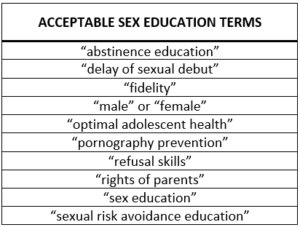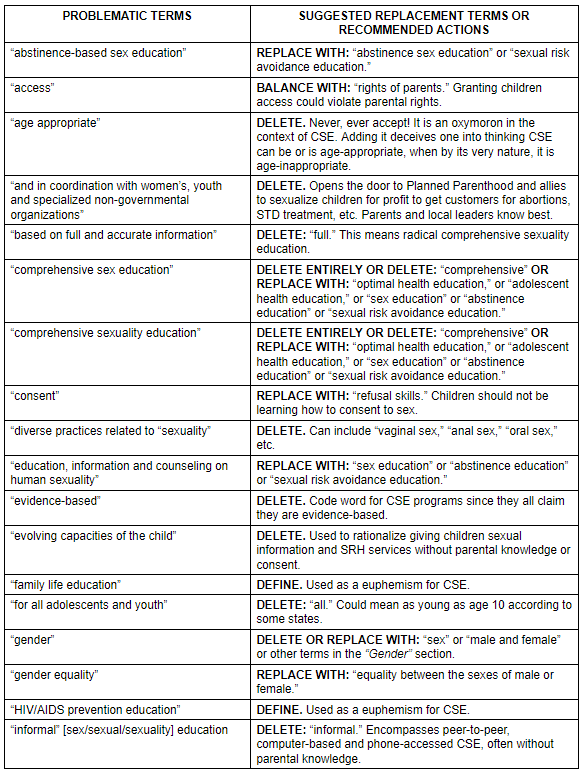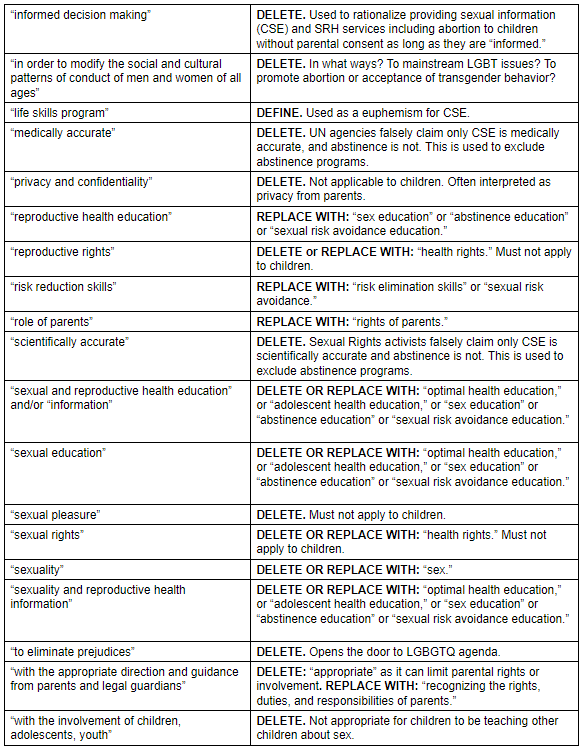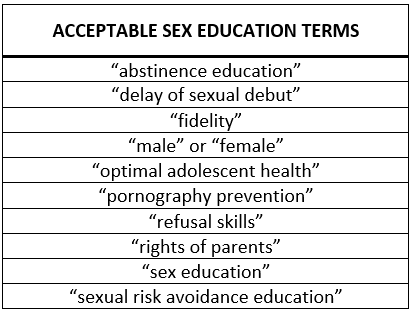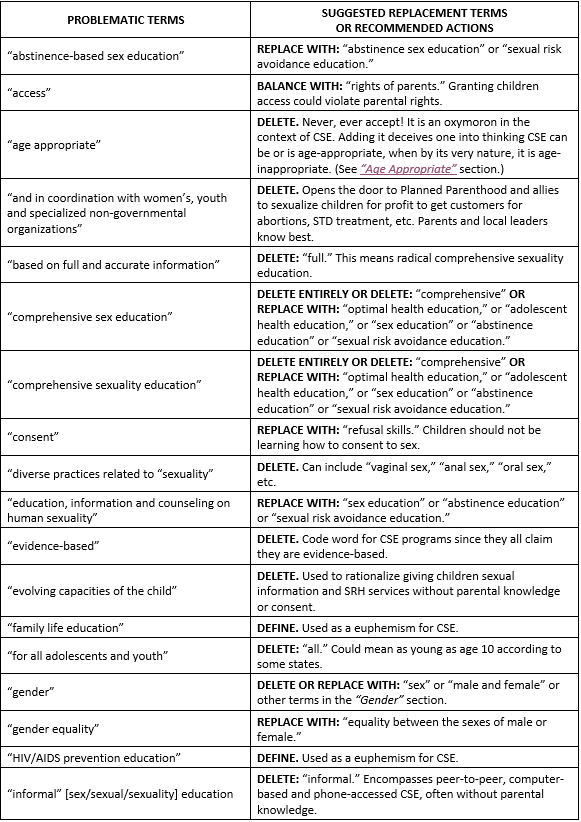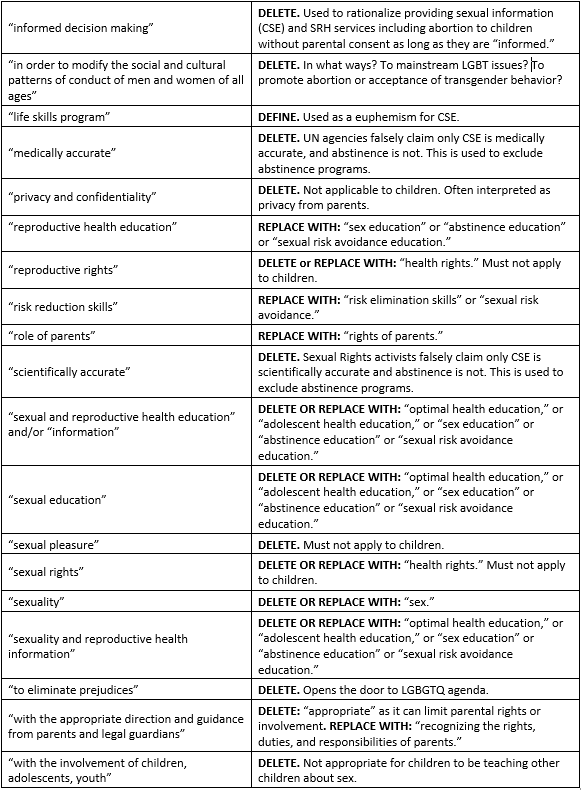Many terms were once effective modifiers that served to protect children from exposure to harmful and explicit sexuality education. This is no longer the case, as the terms have become the most effective strategy used by sexual rights activist to get CSE adopted into legislation and State Department of Education sex education program requirements as accepted curricula. These terms are now used to engender a false sense of security in those who want to protect the innocence of children, and it has become meaningless. It is these sexual rights activists who are implementing sexuality programs for children who will determine the definition of these terms and not the policymakers who believe that the use of the term will protect kids.
The following terms can no longer be considered protective language because of different notions of what is actually defined safe for children.
CHART FOR NAVIGATING CSE TERMS
Strategies
Strategy #1:
Always insist on replacing references that are intended to refer to CSE with the simple term “sex education.”
Comprehensive sexuality education (CSE) is often disguised under many names including:
“sexual education”
“comprehensive sex education”
“education, information and counseling on human sexuality”
“comprehensive sex education”
“comprehensive sexual health education, information and services”
“sexuality and reproductive health information”
“family life education”
“HIV/AIDS prevention education”
“life skills program”
Replace such terms with “sex education.” Be sure to omit any references to “comprehensive” or “rights” related to sex education.
Strategy #2:
Don’t Be Deceived by the “Age-Appropriate” Strategy. The most deceptive and effective strategy used by CSE advocates to get CSE provisions adopted is to modify CSE with the phrase “age-appropriate.” Many governments fall for this tactic because they don’t understand that the “age-appropriate” modifier is meaningless. It may serve to make governments feel better about accepting CSE, but it will not and cannot change the harmful content of CSE.
This is because by its very nature, CSE is never appropriate for any age. “Age-appropriate comprehensive sexuality education” is an oxymoron—there is no such thing because the UN and IPPF (the largest providers and promoters of CSE worldwide) define CSE to encompass sexual orientation, gender identity, sexual pleasure, abortion and more. That fact doesn’t go away by simply adding “age-appropriate” to it.
Strategy #3:
Avoid All Deceptive CSE Terminology. Don’t be deceived by the “definition” or “anchor language” strategy used by CSE advocates. Since CSE advocates are well aware that the term “comprehensive sexuality education” is highly controversial, their fallback position is to propose as many elements from their program descriptions as possible. This makes it almost impossible for anything other than a CSE program to meet all the requirements. The following euphemistic terms are most often listed in the descriptions of UN-supported CSE programs and should be avoided at all costs, even though they may sound harmless.
Deceptive CSE Terms that Should Always be Avoided
“age-appropriate” – See Strategy #2 above. See also “Talking Points to Defeat CSE Provisions” – Talking Point #11.
“appropriate” – The term “appropriate” (or “as appropriate”) when modifying “parental guidance” or parental involvement in the implementation of CSE is deceptive because it can be interpreted two ways. Who decides what is appropriate for children? People of good faith believe it will be interpreted to mean that when parents feel it is “appropriate” they can be involved. However, CSE advocates insert “as appropriate” to limit parental involvement because they believe it is only “appropriate” for parents to be involved if they support the controversial sexual values taught in CSE.
“according to” or “consistent with” the “evolving capacities of the child” – Who decides what is consistent with a child’s capacity? How do governments determine this? Parents’ rights are necessarily limited by such an arbitrary and unmeasurable standard. While this CRC language may sound good, it is being distorted to mean that any age restrictions on sexual activity and explicit sexual information are inappropriate since each child’s capacity to have and enjoy sex evolves at a different rate.
According to IPPF and UNICEF, children should have the right to consent to sex and sexual health services without the knowledge or consent of parents if they desire such. In their twisted thinking, the very fact that a child desires to have sex or to receive explicit information about sex indicates their capacities have evolved enough to not involve the parents. Consider the following examples:
UNICEF’s publication Legal Minimum Ages and the Realization of Adolescents’ Rights states:
- “…for adolescents, the possibility to have access to sexual and reproductive health services without parental consent is a critical dimension of access.” (p. 30)
- “In accordance with their evolving capacities, children should have access to confidential counseling and advice without parental or legal guardian consent, where this is assessed by the professionals working with the child to be in the child’s best interests.” (p. 32)
- The World Health Organization cites the “evolving capacities” standard to justify giving adolescents as young as age 10 “sexual and reproductive health services without parental consent” as follows: “Human rights standards at the international, regional and national levels are well developed regarding the protection of adolescents under 18 [WHO defines adolescents as people aged 10–18] from discrimination in accessing both information and services for sexual health. They also require states to guarantee adolescents’ rights to privacy and confidentiality by providing sexual and reproductive health services without parental consent on the basis of their evolving capacities.”
- “privacy and confidentiality” – Privacy from whom? Confidentiality from whom? Many governments are not aware that the provisions granting children privacy and confidentiality rights would be interpreted to mean privacy and confidentiality from parents.
The goal of SIECUS and Planned Parenthood and other activists is to abolish parental consent laws for controversial services such as abortion, contraception, and sexual counselling or possibly for controversial medical procedures such as transgender hormone treatments or cross-sex surgery as well.
For example, sexual rights activists such as “Advocates for Youth”, the youth arm of Planned Parenthood, claim that a child’s “right” to sexual and reproductive health includes a right to “full access to confidential youth-friendly and evidence-based sexual and reproductive health services.” Confidential services means without the knowledge and consent of parents.
Clearly, any references to confidentiality or privacy in relation to children, youth, or adolescents should be opposed in all legislative negotiations.
“evidence-based” – This language is aimed at excluding religiously-based or abstinence-based programs that sexual rights activists claim are not based on evidence. In fact, SIECUS claims that only CSE programs are evidence-based and that abstinence programs are harmful.
“based on full and accurate information” – Who decides what is “full” or “accurate”?
“for all adolescents and youth” – Adolescents are defined by the UN as starting at 10 years old. Most parents would consider the explicit materials found in UN-supported CSE programs to be inappropriate for adults, let alone children. If this is for “all” youth, what about those who have religious objections to the promotion of LGBT rights or abortion? Can they be exempted?
“with the appropriate direction and guidance from parents and legal guardians” –This phrase is intended to subject the parents’ role to what others deem “appropriate.”
“with the involvement of children, adolescents, youth” – At what age? How will they be involved? We should not accept the idea that somehow children and youth are supposed to be involved in developing and teaching sex education. Children do not have the expertise or knowledge, capacity, or even brain development to be addressing sexual issues with each other.
“and in coordination with women’s, youth and specialized non-governmental organizations” – This specifies that CSE programs must involve outside entities, and the most likely ones that would be involved are those that have CSE programs to sell, such as Planned Parenthood.
“in order to modify the social and cultural patterns of conduct of men and women of all ages” – What kind of social and cultural patterns need to be modified? Sexual and gender norms? In what way do they need to be modified? To embrace homosexual and transgender rights? Most CSE programs are not just aimed at fostering equality between the sexes, but rather at mainstreaming LGBT rights and behaviors.
“to eliminate prejudices” – Prejudices against whom? Homosexuals, lesbians and transgender individuals? This is dangerously open ended.
“and build … risk reduction skills” – Risk reduction skills assume children will be sexually active and focus on only reducing the risk of pregnancy or disease with condoms or contraceptives. “Risk reduction” education programs usually do not promote abstinence or fidelity; those are “risk elimination” skills.
Strategy #4:
Ensure that the “rights of parents” always modifies any language providing youth with, or granting youth “access” to, sex/sexual/sexuality services, education or information of any kind. A pattern we see again and again is that CSE proponents will fight aggressively to keep out any mention of the “rights of parents” or will try to insert language relegating parents to only having a “role” along with other stakeholders.
Suggestions:
- Any time there is a provision regarding sex or sexual education, it should always recognize the right of parents to direct that education.



